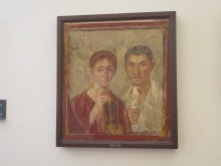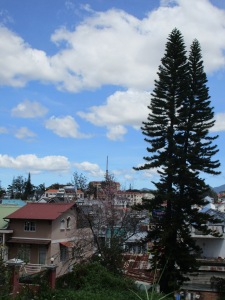Before you make up your mind on what your impression of Naples is, you should either read what I am about to write or go and visit it for yourself. If possible I would suggest the latter.
When I was back- packing my way around Europe with my girlfriends, we decided to bypass Naples because of the rumours we had heard and read…”Watch out for all those men who hassle women on their own and be careful of pick pockets.” There were other negative comments I’m sure but this is the one that stuck in my mind. It was definitely not on the ‘bucket list’ of most travellers back then and, unfortunately, not so for some even today. I must confess that I would not have chosen to visit Naples this time around while in Italy if it hadn’t been for Hubby and some friends who lived there in the ’80’s. At first, I met their enthusiasm for this great city with scepticism, but thankfully my open mind and curiosity won over. Here are my impressions of this controversial city which will hopefully give you some idea why people either love it or hate it, or perhaps fall somewhere in between.
Architecture
The proliferation of fine old buildings reflecting a mix of architectural styles including Baroque, Gothic and the more modern art deco designs introduced by Mussolini before the second world war are outstanding. In fact, Naples was declared a UNESCO World Heritage Site in 1995. There are hundreds of beautiful churches, castles and palaces, and famous piazzas commemorating the city’s heroes in its historical centre.

Its Setting
Naples has been gifted with an ideal setting. The beautiful Bay of Naples provides it with one of the world’s busiest ports as well as gorgeous sunsets. It is the launching pad for ferries travelling to one of Europe’s most glamorous regions: the Almalfi coast, Sorrento, and the islands of Capri and Ischia. The mountains of Vesuvius and Campi Flegrei provide another lovely backdrop. Surrounding all of this are miles of fertile land which produce fruit and vegetables year round due to the mix of Mediterranean and tropical climates.
The Narrow Streets
It’s famous for its one-pedestrian, cobble stoned streets strung with lines of laundry and hanging off balconies. Everyday life is highly visible and can be chaotic but that’s Napoli. I never felt unsafe or encountered any rude behavior. Shops with mouth-watering pastries and cafes serving up the best coffee from the region, abound. It’s almost impossible not to stop and sample some of this so why not indulge? As we discovered, a coffee and a delicious pastry will cost 2 or 3 Euros… about 3 to 5 Canadian dollars.

The National Architectural Museum
This museum is a must see. It houses one of the world’s most complete collection of sculptures reproduced by the Romans from their older Greek compatriots, as well as mosaics and paintings from the cities of Herculaneum and Pompei which were devastated by the Mt. Vesuvius eruption in 79 A.D. The first floor of this magnificent building is devoted to sculptures depicting Roman heroes both real and mythological. You can’t help but be mesmerized by the beauty of both the male and female anatomy…especially those male bums! Another sculpture which should not be missed is the “The Torture of Dirce” or the Farnese Bull carved from one solid piece of Italian marble. Michelangelo worked on its restoration. The second floor is filled with lovely mosaics and paintings rescued from the ruins of Pompei. Apparently you can see more of how life was lived at that time than if you went to visit Pompei itself. In recent years a little room portraying the sex life of the citizens has been added. Now dubbed the ‘porno room’ it has drawn considerable attention. My thoughts on this display were that it’s not so different from the tantric sex motifs one can view in India. Good for Napoli for daring to portray the reality of their past life.

The Torture of Dirce sculpture built AD 212 to 216.
Teatro de San Carlo
The ornate Teatro de San Carlo was built in 1737 making it the oldest working theatre in Europe. We were fortunate to hear one of the best symphony concerts I have ever heard, not only because of the wonderful acoustics but also the program conducted by Leonard Slatkin from the US. His excellent conducting skills, the appearance of Alexi Volodin, a Russian pianist who received two encores and could have had more, and an interesting modern piece composed by Slatkin’s wife, Cindy McTee, made this a memorable evening. The icing on the cake was accidentally meeting Slatkin and McTee at the Architectural Museum the following day where we had a great chat about the previous night’s performance and other things musical. Hubby was in his element sharing stories of great conductors and musical performances he attended during his employment at Roy Thompson Hall in Toronto.

The Cappella Sanservero
The Sansevero Chapel Museum is a sepulchre located in the heart of Naples. Created by Giueseppe Sanmartino, its prime focus is the Cresti Velato or Veiled Christ. People of strong faith, or not, can’t help being moved by the intricate realism of this sculpture where every nuance of Christ’s suffering is vividly portrayed in his body shrouded with a thin veil so real you can almost feel it. Many other masterpieces can be found in this chapel making it one of the ‘most impressive monuments ever conceived by the human mind’.
Neapolitan Food
As all Neapolitans would like us to know, pizza was invented by them, but did you know that the Margherita pizza is named after Queen Margherita and that the ingredients for a true Neapolitan pizza are regulated by law? Since 2004 only a special kind of flour, yeast, and mineral water can be used so only those restaurants who meet these requirements can claim they make the ‘real thing’. Patrons of these restaurants will know because each restaurant must display a special logo at their entrance. The Neapolitans also lay claim to being the masters of spaghetti especially the seafood dish. Then, as I already mentioned, there are those yummy pastries which again they are masters at producing. Napoli’s signature pastry is called a sfogliatelle….light layers of flaky pastry filled with sweetened ricotta cheese.

Art and Culture
Their art and culture, which goes back centuries, is still very much in evidence today especially in their churches and major museums. After admiring the Duomo, the largest and most significant of Naples’ churches, we visited the Misericordia where Michelangelo Caravaggio’s famous art piece …”The Seven Acts of Mercy”…is housed. Another major undertaking exposing the culture of the Romans is ongoing. An underground city under the present day city is slowly being unearthed and giving us a close up of early Roman life.

Caravaggio’s “The Seven Acts of Mercy”
There are numerous other sites for which Naples is noted, but I would need at least a week or more to see them all. They are all the things that people love about this city. Now for the things that some people hate about it so much that they have vowed never to return.
Garbage
A few years ago, Naples made the world news when the garbage collectors went on strike for more than a year. You can imagine the problems this created which didn’t do anything to help the city’s already negative image. I hate to say that even though the strike is over the city is still having some problems. Although some garbage bins were visible, there were not enough as garbage was usually spilling out around them, not to mention everywhere else. Nevertheless, I don’t think their problem is much worse than many of the cities I have seen in South East Asia, such as Phnom Penh in Cambodia and the country roads in Viet Nam. Proper garbage disposal and the citizens’ concern for keeping their cities or towns litter free simply aren’t a priority in many parts of our world. For Italy it has always been Naples and many contribute this to the poor choice in municipal government influenced by the Camoura, an organized crime network.

Graffiti
Yes, there is a good deal of graffiti in Naples, which I don’t think is worse than some other European cities I have seen. I remember that Lisbon and Athens both had problems with it as I suspect many other European cities have. Walking around the historic centre of Naples, I spied one shop keeper painting over some of the graffiti on his storefront. It is a shame that the city hasn’t been able to stem the tide as it does contribute to its overall grungy, dirty appearance.
Begging, Touts and Pickpockets
Naples is one of the poorest places in Italy so there is bound to be begging with desperate people looking to make money any way they can. I noticed some begging around the Central Train Station but none on the trains or the subway. We were approached by one tout who wanted to help us purchase our tickets, but he backed down fairly quickly when we stated firmly that we didn’t need his help. We experienced much worse in the medinas of Morocco.
Lying, Cheating, and Thieving
Over the years Naples has been accused of them all. During our two-day visit, we encountered only one incident: lying. This happened where we least expected. After finishing a delicious Neapolitan meal of antipasta, seafood spaghetti, red house wine, and frizzante (fizzy water), and of course, the crusty bread served at every meal, we were presented with our bill which totalled 55 Euro…about $80 Canadian. We were astounded! Hubby had eaten at this restaurant last year and paid much less. This was our reason for returning…good, authentic food cooked up by the family who run the place and at very good prices. They had no real menu other than a set price for whatever they were cooking for the day and another higher price if we chose what we wanted. He told us they had seafood pasta so we thought, why not, if that’s what is on the menu for the day. He didn’t present any other options. When Hubby picked up the bill the whole place heard a loud, “What”? Immediately our waiter left our table and returned with a new price of 45 euro! Having looked at their pricing for the two sets (with or without choice) as we were entering the restaurant and seeing that the counter offer still wasn’t good enough, I jumped in and pointed to the sign at their door. Realizing again that he didn’t have a strong rebuttal, he brought the price down to 40 euro. Allowing for the possibility that prices had gone up from last year, we stopped at this point and paid our bill. If we hadn’t been so savvy, he would have gotten away with it. Too bad as this is the sort of thing that Napoli has been known for and why people are reticent to go back.

Neapolitan seafood spaghetti.
My conclusion on Napoli is that like many cities it has its good and bad points. If you go looking for the good, with an open mind, and some common sense, you will accept it for what it is and leave on good terms. However, if you buy into the negative hearsay and look only for its bad points, you will come away with the wrong impression and never want to return. If you choose the latter route, then I think you will have missed experiencing a city which is vibrant and real. Beneath the layers of grime you will find beauty and the remains of a storied past.
A gallery of additional images of Napoli. Click on each picture for the caption.















































